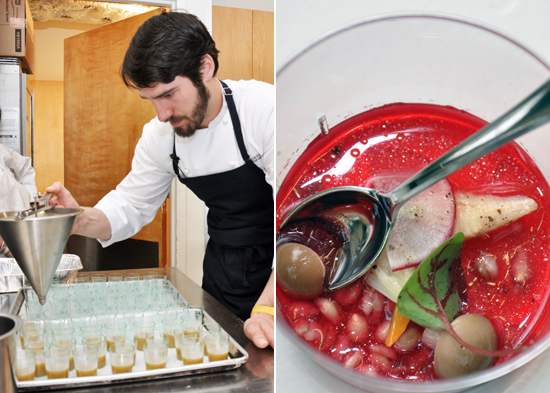The highly-anticipated book Modernist Cuisine: The Art and Science of Cooking (March 2011) is a six-volume, 2,400-page, abundantly illustrated opus that sets to make the science and technology of cooking that explores and explains a myriad of processes and techniques at length.

For years, Nathan Myrhvold, Chris Young and Maxime Bilet worked along with a 20-person team to create the tome, researching, developing and photographing the book’s 1,522 recipes. The book’s launch was celebrated with an all-night party at ICE in March and yesterday, the team returned to give a demo to ICE’s students. The book’s co-author, ICE alumnus Maxime Bilet (Culinary ’05) and Cooking Lab Chef Grant Crilly walked through the project, explaining the making of Modernist Cuisine, their motivation for the project, how techniques and dishes were developed and much more. The outlined several of their guiding principles, noting that in addition to balancing the art of science and art and doing thorough and complete research, they also just wanted to make food that was delicious and playful. Not only did the seek to push the bounds of what science can do; they also looked at tradition and what they could learn from the past.

To illustrate their methods and development process, Bilet and Crilly walked through their approach to the fine art of sauce making, calling it an “ideal vehicle for sharing the insights of Modernist Cuisine.” The team looked at classical sauce-making, but quickly saw how modern techniques could be used to create sauces. For example, Bilet talked about how using a pressure cooker not only makes the process of making stock faster, it also extracts more flavors and adds a layer of caramelization. The spoke of using many techniques, including sous-vide, pressure cookers, vacuum reduction, freeze reduction, centrifuge and different solvents to extract and manipulate the flavors of a sauce.
To show how they used modern techniques to create sauces, Chef Crilly prepared a Rare Beef Stew by cooking meat in sous-vide for three hours and then centrifuging it to extract the jus. The jus was then served with a selection of vegetables and herbs. He also made incredibly flavorful gravy from shallots, duck stock, duck juice and rendered foie fat blended with a rotor-stator homogenizer to form an emulsification. While not everyone has this kind of equipment, Bilet pointed out that many of the recipes in the book are accessible to the home cook, noting that a good pressure cooker only cost around $100 and can be used to achieve dramatic results. The demo was an incredible opportunity for ICE’s students to learn from some of the world’s most incredible chefs and take the techniques with them on their culinary and professional journey.



